AT THE CINEFAMILY IN LOS ANGELES;
"SHOWS JUST HOW POWERFULLY CONSPIRACY THEORIES CAN CORRODE OUR MODERN SENSE OF REALITY"
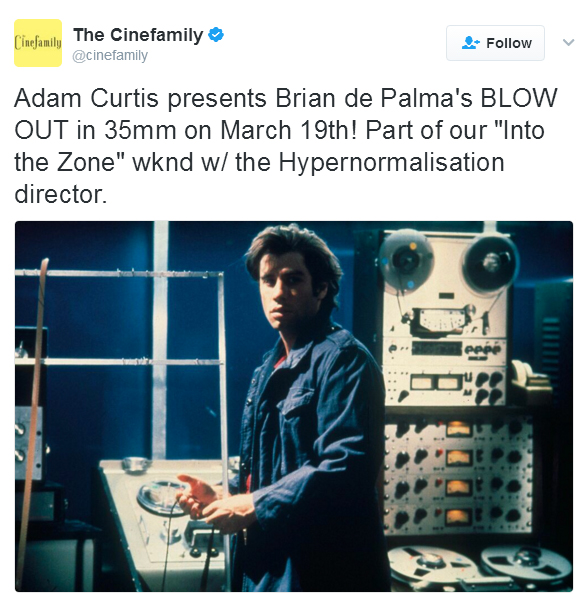
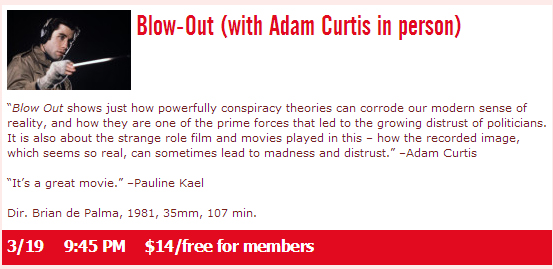
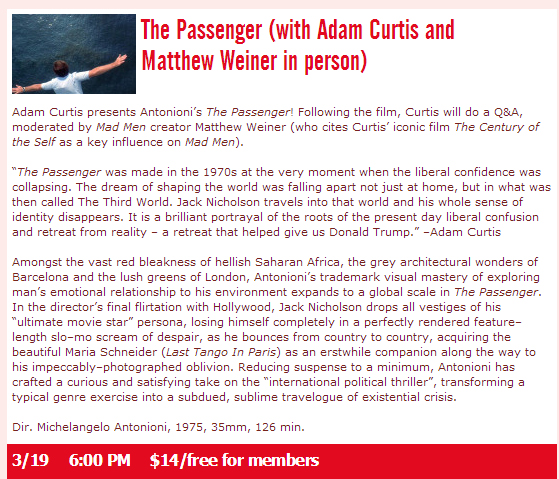
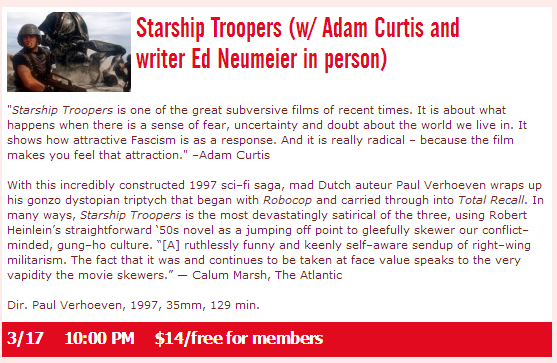
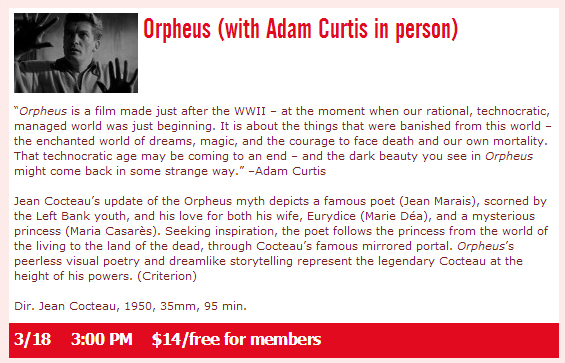


 Hello and welcome to the unofficial Brian De Palma website. Here is the latest news: |
|---|
E-mail
Geoffsongs@aol.com
-------------
Recent Headlines
a la Mod:
Listen to
Donaggio's full score
for Domino online
De Palma/Lehman
rapport at work
in Snakes
De Palma/Lehman
next novel is Terry
De Palma developing
Catch And Kill,
"a horror movie
based on real things
that have happened
in the news"
Supercut video
of De Palma's films
edited by Carl Rodrigue
Washington Post
review of Keesey book
-------------
Exclusive Passion
Interviews:
Brian De Palma
Karoline Herfurth
Leila Rozario
------------
------------
| « | March 2017 | » | ||||
| S | M | T | W | T | F | S |
| 1 | 2 | 3 | 4 | |||
| 5 | 6 | 7 | 8 | 9 | 10 | 11 |
| 12 | 13 | 14 | 15 | 16 | 17 | 18 |
| 19 | 20 | 21 | 22 | 23 | 24 | 25 |
| 26 | 27 | 28 | 29 | 30 | 31 | |
De Palma interviewed
in Paris 2002
De Palma discusses
The Black Dahlia 2006

Enthusiasms...
Alfred Hitchcock
The Master Of Suspense
Sergio Leone
and the Infield
Fly Rule
The Filmmaker Who
Came In From The Cold
Jim Emerson on
Greetings & Hi, Mom!
Scarface: Make Way
For The Bad Guy
Deborah Shelton
Official Web Site
Welcome to the
Offices of Death Records
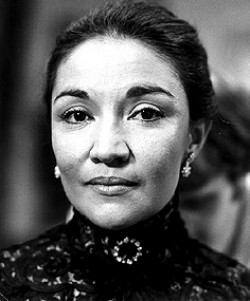 Miriam Colón, who portrayed Tony Montana's mother in Brian De Palma's Scarface, died Friday. She was 80. According to Deadline's Patrick Hipes, Colón's husband "told the Associated Press that Colon died owing to complications from a pulmonary infection."
Miriam Colón, who portrayed Tony Montana's mother in Brian De Palma's Scarface, died Friday. She was 80. According to Deadline's Patrick Hipes, Colón's husband "told the Associated Press that Colon died owing to complications from a pulmonary infection."In the early 1980s, Al Pacino was based in New York, and thus most of the parts for Scarface were cast from auditions that had been set up at the Puerto Rican Traveling Theater, including, of course, Colón herself. Underneath the frame from Scarface below is an excerpt from a 2003 Fresh Air interview with Colón (hosted by Terry Gross; transcription via Puerto Rico Herald) in which she discusses her role in the film.
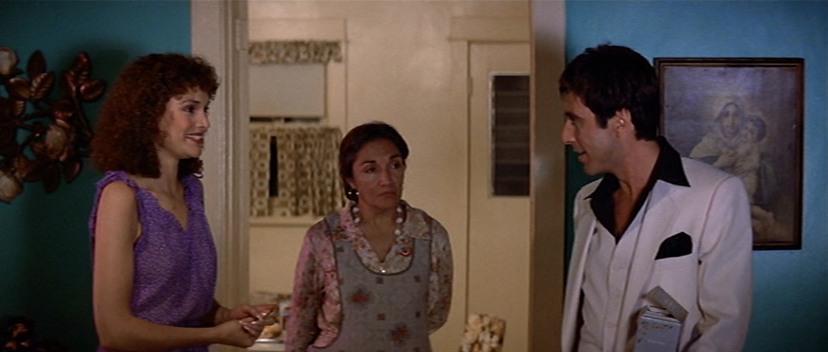
GROSS: You're now starring in "The Blue Diner." What does that role mean to you professionally?Ms. COLON: It's a good role. It's a woman that is very simple, that is hardworking, that has a sense of honor and dedication. She cares for her daughter, and she's very vigilant about what that daughter is going through, what is she getting involved, you know, like all mothers. In a way this woman reminds me very much of my own mother, whom I lost about three years ago; may she rest in peace.
GROSS: What about this character reminded you of your mother?
Ms. COLON: Because my mother was this hardworking, she and I would fight sometimes. My mother maybe went to the sixth or the seventh grade, but she had a wisdom in herself, a kindness, a humanity that really determined my life. I had such admiration for her, and I was so sorry that she had to work so hard. But such dignity and pride, she was the best image I had. I wish I could be like her.
GROSS: Is it fair to say, though, lately you've been playing mothers who are more conservative and strict than their children, I mean, you know, who are from a culture that is more conservative and strict than the culture their children are growing up in?
Ms. COLON: Yeah. And I just relish--I guess that's why the people loved so much what I did in "Scarface." This was another woman--in fact, I enjoyed...
GROSS: Describe your role in that.
Ms. COLON: Oh, the mother was my mother. The mother in "Scarface" is my mother, so that's another instance in which I just swam into it. It was like a tailor-made dress that was made for me: the mother that also works very hard; that is very stern; that has standards in her house; the fact that she is poor and they may not have an automobile, that they may not have a nice house, that they may live in the outskirts of the city cannot under any circumstances be used to try to put them down or to be disrespectful to the them. And this is what she did to the character played by Pacino. The thing of honor, the stern--well, she's the only one that defied him, told him, `Get the hell out of here,' that didn't wind up with her head cut off. I love characters like that, and I think I can play them very well. And that's also great because I have such sympathy for those women.
GROSS: Do you have a favorite scene from "Scarface" that you're in?
Ms. COLON: The scene with Pacino where I'm watching him coming to introduce himself into our life again. And I know that he's pushing drugs, and I know that we may be poor, but we are not in the drug world. And I know that those suits cannot be bought from working in a factory or something like that. So I think I instinctly know. But what is worse is his insinuating himself into my kitchen, into my house, into the relationship with my daughter, which is all I have left, is very dangerous. And that's why I throw him out. And everything I said would happen happened. He destroyed her...
...GROSS: Do people recognize you a lot from that role?
Ms. COLON: Oh, yes.
GROSS: "Scarface" is such a cult film now. I mean, it has such a following.
Ms. COLON: Oh, yes. You know what? Youngsters. I've had the weirdest, the weirdest, all true, episodes in the subway platform.
GROSS: Yeah?
Ms. COLON: It's happened not twice, not four times, at least a half a dozen times. They're staring, and I say, `Oh. Oh, my God, they're coming in my direction. What are they here for? Are they going to push me off the platform or something, or are they going to take my ring or something?' And then it turns out that they come close and they say, `Mama Montana?' I say, `Si, I'm Mama Montana.' They say, `Yeah!' They have done this scene for me saying my lines and his lines. They have memorized the entire scene. But I've seen kids that I know they don't have any money, and they told me, `Oh, I own that film.'

There weren’t actually too many people working on Nightdreams, though. [Stephen] Sayadian’s partner, Francis Delia — credited as the director of photography (sometimes as director) on the film, using the pseudonym “F.X. Pope” — actually operated the camera. Delia — a native New Yorker — had studied at Cooper Union and worked as as commercial photographer for Madison Avenue Ad agencies, but he was still at the very start of his career, according to his IMDB credits.(As an aside, your humble writer actually met him once and spent an afternoon talking with him at a screening of his 1988 movie Freeway — held in a tiny room at Raleigh Studios as I recall — when he was looking for a music label to release the soundtrack. Sadly, our label passed on that opportunity).
But make no mistake, despite any involvement in Nightdreams by others, even Delia and Stahl, this is clearly a Sayadian film, a vision borne from his unique imagination and talents.
Sayadian has said that maybe five people worked on the crew of the low-budget art/porn film — in addition to Sayadian and Delia, there was a focus puller who made sure the camera stayed in focus, and a construction supervisor who worked on the sets that Sayadian carefully had art directed and he helped build the sets too. Despite the budget limitations, this gorgeous 35mm production is about visually similar — with its German Expressionist-influenced lighting scheme — with the production values of a high-quality, low-budget TV adverts...
...The thriller sequence seems to be patterned on Brian De Palma’s Dressed to Kill (Delia did the key art photography for the movie poster for Dressed To Kill).
Film Comment - Guilty Pleasures: Brian De Palma
"There was a very strange movie [Night Dreams (1981, by F. X. Pope)] that was made by the people who made Cafe Flesh. I can’t remember the title, but it’s the one before Cafe Flesh, and is very avant-garde. What makes it so incredible is its surrealism. It was shot very surrealistically and very expensively. The premise is that there’s a woman, Dorothy LeMay, in a kind of psychological observation chamber which is being watched by this psychiatrist. She’s constantly masturbating the whole time she’s being watched. While she’s masturbating, she’s, of course, having all these fantasies. One was when she was a little girl and the jack in the box possessed her. Then she’s a housewife and a black guy, Fast Talkin’ Freddy, in an Aunt Jemima box comes after her—it’s obsessed with boxes."

 Salon's Kevin Smokler spoke with Howard Deutch and Lea Thompson, who met and fell in love 30 years ago while (respectively) directing and acting in the John Hughes movie Some Kind Of Wonderful. Deutch talks about landing in "movie jail" after taking advice from Brian De Palma, although he would eventually end up being brought back in to make the movie. Here's the excerpt:
Salon's Kevin Smokler spoke with Howard Deutch and Lea Thompson, who met and fell in love 30 years ago while (respectively) directing and acting in the John Hughes movie Some Kind Of Wonderful. Deutch talks about landing in "movie jail" after taking advice from Brian De Palma, although he would eventually end up being brought back in to make the movie. Here's the excerpt:Here in the present, how often does “Some Kind of Wonderful” come up for each of you?Howard Deutch: Quite a bit, actually. Which is ironic because it wasn’t considered a hit when it came out. But it’s a meaningful movie to people and I met my wife on set so it’s a meaningful movie to me.
Most people talk about it like I talk about a movie I didn’t direct and I don’t think the other person has heard of. They don’t talk about “Some Kind of Wonderful” as completely unknown or an underdog but they cherish it because it hadn’t been this massive hit movie. It’s not like they’re saying, “Have you ever seen this little movie, “Back to the Future?”
Lea Thompson: It wasn’t a bomb, but definitely a disappointment. Yet it seems to have a broad base around the world that are really touched by it and quote it. I just asked on Instagram and Twitter about everyone’s favorite line from the movie and was amazed how many people have so many different memories of it.
I also hear from more men than women who love it, but I can’t tell you why. Maybe because it’s two girls fighting over a guy? Or because it’s about a guy trying to find himself? I also hear from a lot of gay women who love Watts.
You both have worked more or less continuously in films and television since 1987. Where do you see “Some Kind of Wonderful” in the arc of your work?
Deutch: I had only made one other movie up to that point and couldn’t cast the role Eric Stoltz ended up playing. Around that time, I ended up on a plane with (director) Brian De Palma, whom I didn’t really know. He told me, “If you can’t cast it, don’t make it.” I mentioned this to John and suggested I do one of his other scripts and ended up in movie jail. Paramount locked the door of my office.
Martha Coolidge (director of “Valley Girl”) was brought on to replace me. The script was originally a broad comedy and John made rewrites to take it in the direction of Martha’s sensibility, which was darker and more adult. Martha cast Eric. But when she and John had disagreements, I was brought back with a different script, a leading actor. A different movie.
Thompson: I was 26 when I made “Some Kind of Wonderful.” Right before, I had made “Howard the Duck,” which got terrible reviews. I thought my career was over. Eric Stoltz, whom I had become friends with while working together on both “Back to the Future” [Stolz was the original Marty McFly] and “The Wild Life,” acting as a messenger for Howard, delivered the script to my house. Howie saw me as right for Amanda even though I had already turned it down because I thought Watts [the character ultimately played by Mary Stuart Masterson] was the better part. I needed a job. Amanda was my second chance.
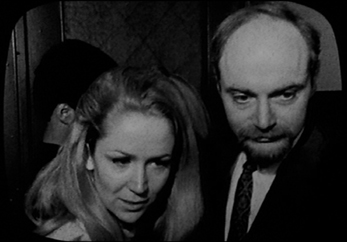 I really enjoyed seeing Jordan Peele's uproarious Get Out in a packed theater a couple of weeks ago, and found it to be one of the more creative films I've seen in a while. National Review's Armond White is not a fan, and mentions Brian De Palma's Hi, Mom! a couple of times in his review, which is titled "Return of the Get-Whitey Movie"...
I really enjoyed seeing Jordan Peele's uproarious Get Out in a packed theater a couple of weeks ago, and found it to be one of the more creative films I've seen in a while. National Review's Armond White is not a fan, and mentions Brian De Palma's Hi, Mom! a couple of times in his review, which is titled "Return of the Get-Whitey Movie"...Get Out does not rank with America’s notable race comedies — Brian De Palma’s Hi, Mom!, Ossie Davis’s Gone Are the Days! (Purlie Victorious), Robert Downey Sr.’s Putney Swope, Melvin Van Peebles’s Sweet Sweetback, Hal Ashby’s The Landlord, Rusty Cundieff’s Fear of a Black Hat, Skin Game or any of the genre spoofs by the Wayans family, particularly the ingenious Little Man, or the recent Eddie Murphy films (The Klumps, Norbit, Meet Dave, A Thousand Words) that are so personal and ingenious, they transcend racial categorization.But unlike Eddie Murphy, a masterful actor with a mature sense of humor, Peele fails because has not created credible characters. Chris and his ghetto friend Rod (Lil Rel Howery), who works for the TSA, are attitudes, not complex beings. The other blacks Chris encounters as servants on Rose’s family estate are no better than Trayvon Martin–type effigies — zombie-like when not sorrowful and tearful. Exploiting black people’s tears, paranoia, and pain without providing reflex is offensive — whereas the great “Be Black, Baby” sequence of Hi, Mom! caught audiences in their own racial prejudices and forced them to laugh. (Here, LaKeith Stanfield’s impersonation of comic Dave Chappelle’s still-puzzling neurosis is too alarming to laugh at.)
Peele’s self-congratulatory revenge humor has one particularly notable irony: It’s tailored to please the liberal status quo. His pace seems slow largely because the jokes are obvious: Bitch-goddess Rose trolls black sports websites in her bedroom, which is covered with basketball posters, recalling Scatman Crothers’s Afro erotica in The Shining. Chris even gets confined in a symmetrically furnished den with a 1960s TV console, Kubrick-style.
Once again, the 1960s serve as a race hustler’s vengeful reference point. But when the get-whitey genre was initiated in those blaxploitation movies made after the turmoil of that decade, artists from Melvin Van Peebles and Larry Cohen to Bill Gunn and Gordon Parks toyed with various genres to dramatize American social and economic circumstances. Black political consciousness was being realized on screen for the first time. Get Out is the recrudescence of Obama-era unconsciousness. Reducing racial politics to trite horror-comedy, it’s an Obama movie for Tarantino fans.
 Brian De Palma's Blow Out will be the first of five films to be screened and discussed as part of a five-week course titled "Film/Style." The course, currently filled to capacity, will be taught by Diana Martinez at Film Streams in Omaha, Nebraska, every Sunday from February 26 to March 26. The course syllabus lists Blow Out as the film to be screened and discussed February 26 in terms of frames. Here is how the Film Streams site describes the course:
Brian De Palma's Blow Out will be the first of five films to be screened and discussed as part of a five-week course titled "Film/Style." The course, currently filled to capacity, will be taught by Diana Martinez at Film Streams in Omaha, Nebraska, every Sunday from February 26 to March 26. The course syllabus lists Blow Out as the film to be screened and discussed February 26 in terms of frames. Here is how the Film Streams site describes the course:Film/Style is currently at capacity. To be added to the wait list or receive notifications about our next Courses offering (coming in Spring 2017!), please email Film Streams Education Director Diana Martinez.Film Streams Courses is a new program of themed, multi-week seminars that will provide adults with an introduction to the tools of film analysis. Every participant will leave better equipped to analyze film aesthetics and examine the tremendously important role film plays in our culture.
Film/Style Step in the vivid worlds of cinema’s most stylish films.
Instructor: Diana Martinez, Film Streams Education Director
Dates: Sundays, Feb 26 – Mar 26, 2017, 11am – 2pmThere is no art form more capable of provoking our senses than film. It can create fantastic places and expose the stark reality of life. Film/Style is an introduction to the aesthetic techniques employed by some of the most influential and challenging filmmakers in the medium’s history.
Film/Style will explore the complex interplay of mise-en-scène, cinematography, sound, and editing that shapes our viewing experience. An international tour of film aesthetics begins with a classic from Brian De Palma, and will conclude with a film by the great Chinese auteur Wong Kar-Wai, with films in between from Czechoslovakia, France, and Germany.
COURSE SYLLABUS
Frames: Blow Out 1981
Rhythm: Daisies 1968
Sound: Holy Motors 2012
Color: The Bitter Tears of Petra von Kant 1972
Texture: In the Mood for Love 2000Cost: $125 General, $75 Film Streams Members, $100 Student/Teacher/Senior/Military Includes Course materials and snacks
 This is a couple of months old, but you'll recall (surely) that this past December, The Film Society of Lincoln Center presented a film series titled, "Going Steadi: 40 Years of Steadicam." Brian De Palma's Carlito's Way and Raising Cain were both included in the series.
This is a couple of months old, but you'll recall (surely) that this past December, The Film Society of Lincoln Center presented a film series titled, "Going Steadi: 40 Years of Steadicam." Brian De Palma's Carlito's Way and Raising Cain were both included in the series.Brian De Palma first used the Steadicam, with Mr. Brown as an operator, in “Blow Out” (1981) for the opening sequence, an elaborate horror movie parody in which a slasher attacks coeds. “Choreographing the shot, getting the psychopath to hold his knife up in front of the mirror at the right time — it was a kind of joyful evening,” Mr. De Palma said by telephone. He went on to use the Steadicam in many films, including “Raising Cain” and “Carlito’s Way,” showing in the Film Society series.For Mr. Brown, who taught himself filmmaking, movies came after a folk-singing career (as part of the duo Brown & Dana) and a stint selling Volkswagens. He found himself working in commercials at a time when the only way to create smooth camera motion was to put the camera on a dolly, in a camera car or on a crane. He was pained by the unwieldy setup of a 12-pound camera on an 800-pound dolly.
“The sight of that pinheaded little camera on that huge dolly and the attendant difficulties of schlepping it around on pickup trucks and laying my paltry rails here and there outdoors really was so absurd,” Mr. Brown said. He wanted to isolate the camera from the motions of the person controlling it — the kind that cause hand-held shots to appear shaky.
The key ingredients were a gimbal, which came from Mr. Brown’s sailing experience; counterweights, to give the camera stability; an articulated arm — an idea he got from a motel desk lamp — attached to a harness that a camera operator could wear; and a way to see through the lens. He originally used a fiber-optic viewer intended for medical examinations.
In a sense, Mr. Brown had realized a dream of filmmakers and theorists who treasured camera motion; it’s hard not to wonder what Max Ophuls or André Bazin would have made of the Steadicam. “Abel Gance — he was fabulous at moving the camera,” Mr. Brown said, referring to the director of “Napoleon,” the 1927 silent classic. “He did extraordinary things, but he didn’t have this tool for stabilizing. I would have loved to have shown up on his set.”
In the earliest Steadicam movies, Mr. Brown operated the apparatus himself, and he continued to do so for three decades. Now, he said, Steadicam operators make expert shots for TV news broadcasts and from the sidelines of sports like football and soccer.
Robert Elswit, the cinematographer on two Paul Thomas Anderson movies in the Film Society series, “Boogie Nights” and “Magnolia,” considers the Steadicam essential. “To me, it’s not a specialty item,” he said. “It’s usually there all the time.” The results, he added, are sometimes “not even necessarily recognizable as a Steadicam shot. You just use it to get something done in a simple way.”
Mr. De Palma cautioned that the Steadicam is only a tool, a way of showing the viewer an environment. “You need a lot of sophisticated technicians to pull off a really good Steadicam shot, and that sort of comes with making movies in the studio system in Hollywood,” he said.
Digital cameras make it less complicated to light scenes, he noted, and the equipment weighs less, leading to what he sees as the Steadicam’s overuse. “You see an abundance of Steadicam shots that are completely ridiculous,” Mr. De Palma said. “God knows, in television, they do it all the time. People are always walking and talking and going around corners.”